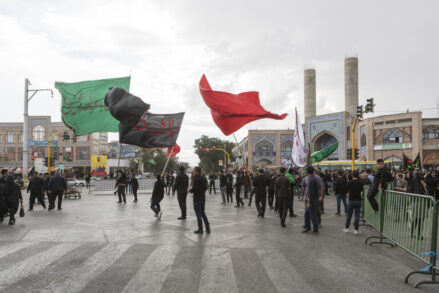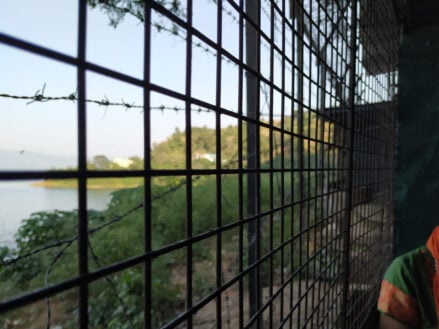In a video being widely circulated on social media, a controversial Hindu leader has called for Christians to leave India in a video that shows a group stomping on images of Pope Francis.
The video, posted on May 26, shows Hindu leader Om Swami Maharaj and a group of around 20 people carrying placards and banners with pictures of Pope Francis, near the Sacred Heart Cathedral in New Delhi, reported Catholic news site UCAN.
In the video, Maharaj spread on the ground a banner featuring a picture of the pope and then, with several others, stomped on it. Slogans of “Pope Francis murdabad” (Down with Pope Francis) were shouted.
The Hindu leader accuses Indian Christians of promoting terrorism and Maoism and demands that they leave India. He adds that if Christians don’t exit voluntarily, they will be expelled by force.
Christians Respond
The blatant video has grabbed the attention of Christian groups in central India who have reported it to police, asking them to stop its circulation.
Richard James, spokesman for the Rashtriya Isai Mahasangh, the ecumenical national Christian forum based in the state of Madhya Pradesh, said the police have been alerted to the video.
“This kind of public display of hate toward any religious group or leader would not be allowed in a civilized society,” James said.
Jaideep Prasad, inspector general of police in Bhopal (capital of India’s Madhya Pradesh state), said that his officers would “not allow anyone to spread discord among people with such videos,” but the video has not yet been taken down.
Last week, speakers at a conference marking four years of India Prime Minister Narendra Modi’s government called for concerted action to uphold the country’s constitution and fundamental rights.
Describing the current religious climate of India, Professor Ganesh Narayan Devy, a scholar on India’s religious and linguistic diversity, noted that anyone expressing a view contrary to Hindu nationalism was deemed “anti-national.”
The conference also heard how 2017 saw a 20 percent increase in the number of violent incidents against Christians.
8 things to know about PERSECUTION IN INDIA
The increase in persecution is a direct result of the ongoing Hindunization of India or Hindu nationalism—essentially, the belief that India must be a Hindu nation, and any other religion is not Indian. This radical nationalism has been spurred on by the political situation in India, which saw a nationalist government elected in 2014. The reasons for increased persecution are many:
-The election of Prime Minister Modi in 2014 was seen by many observers as a tacit acceptance of Hindu nationalism. If anything, Mr. Modi’s tolerance of religious extremism has only increased since his election victory.
-There have been recent calls for the Modi government to address Christian persecution, but those calls have gone unanswered. Of particular concern are allegations that Hindu nationalists are acting in collusion with some local governments and police forces.
-In early 2017, Yogi Adityanath was elected chief minister of India’s most populous state (out of 29 states), Uttar Pradesh. Adityanath is widely known as a Hindu nationalist who has advocated for violence in the name of Hinduism and insists that India is distinctly Hindu. He’s particularly known for stoking violence against Muslims.
-Leaders have vowed activism against religious conversion and working for the reconversion of Muslims and Christians to Hinduism—made international headlines in December 2014 in a public address in the Indian city of Agra (home to the Taj Mahal). The group’s leader, Rajeshwar Singh, declared, “Our target is to make India a Hindu Rashtra (Hindu Nation) by 2021. The Muslims and Christians don’t have any right to stay here. So they would either be converted to Hinduism or forced to run away from here.”
-To achieve their prime agenda, the government is systematically misusing the anti-conversion laws, religious laws, administration, and police to deprive freedom of religion to Christians. Brutal violence is often inflicted on Christian believers by Hindu Extremists, who eventually go unpunished because they have complete protection by the government. As a result, there is a constant rise in Christian persecution.
-Christian converts from a Hindu background bear the brunt of the persecution in India. These believers face harassment on an almost daily basis and are constantly under pressure to return to Hinduism. They are often physically assaulted, hospitalized and sometimes even killed. They live mostly in the countryside, where they face societal pressure not only from family, friends, community members and local Hindu priests, but also from radical Hindus.
-Even Christian charities that are non-evangelistic in nature are having trouble surviving the current climate in India, where their ability to receive international funding is dependent on government approval. For instance, in 2017, Compassion International was forced to close its offices.
-Since the second half of 2014, Hindu radicals launched a homecoming campaign (a.k.a. Ghar Wapsi), designed to lure Muslims and Christians back to the Hindu fold. Several campaigns have been held in which hundreds of people returned to Hinduism. The Ghar Wapsi campaign reached its peak in 2015 and early 2016.
-Recent political events suggest change isn’t in the near future. In the summer of 2017, a new national president was elected. President Ram Nath Kovind has been described by one church planter in an interview with Christianity Today as having “no room for Christians.” Additionally, online polling of Indian readers suggests that Prime Minister Modi’s popularity is in no danger of waning.
*Photo used for representative purposes







